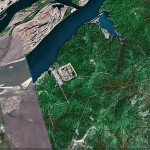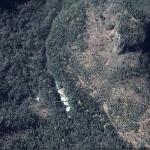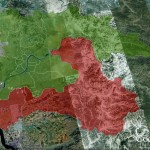When North Koreans talk about their arts, they never fail to mention that it follows the traditions of “socialist realism.” But what is “socialist realism” in visual arts?
This style itself was invented in the Soviet Union of the 1930s and reached its height in the late 1940s when it was imported to the North by ethnic Korean Soviet painters (of whom Pak Wol-ryong was probably most prominent) and Korean students who studied in the USSR.
Most of our readers have some ideas about this style: photographic-like images of heroic workers, brave soldiers and wise leaders engaged in the socialist construction or in struggle against the scheming counter-revolutionaries, imperialists and other assorted villains (the villains appearing as ugly as their reactionary thoughts). In its North Korean variety, the style became even more syrupy, with soldiers’ uniforms in the trenches depicted as if freshly ironed and spotlessly clean.
The topics must be lofty and politically inspiring. In February 2007 North Korean artists had a major exhibition which presented some 500 works. The KCNA, the North Korean wire agency explained what was great about this triumph of creativity and artistic freedom (I use the original translation, helpfully provided by Pyongyang propagandists):
“The works truthfully depicted the revolutionary exploits of the three generals of Mt. Paektu (The ‘Three Generals’ being Kim Jong-il, his father and his mother) and their personality as peerlessly great persons and the national pride and honor of the army and people of the DPRK who hold Kim Jong-il in high esteem as their benevolent father.
Among the works are Korean painting ‘Frontline at night,’ oil painting ‘All 30 millions of people should be ready to fight’ and sculpture ‘Always believing in the people,’ which arouse viewers’ deep reverence and longing for President Kim Il-sung. There are also Korean paintings ‘Calling them proud scenes of the Army-first era,’ ‘I miss my soldiers’ and ‘Long journey for happiness’ and oil painting ‘Our General visits land of Samsu’ that vividly portrayed the immortal feats and the noble popular traits of Kim Jong-il who has made a long journey of the Army-first revolution.”
Great works, indeed! Needless to say, not just everybody can deal with such lofty topics. Under the North Korean system, a painter has to obtain a special certificate to have the right to depict the Three Generals (that is, the ruling family). Those who have received the said certificate are known as “number one artists” and the works which depict the Leaders are, as you might guess, also known as “number one works”.
Most of the number one works are produced by the “Mansudae Creative Group” which include about one thousand artists and some 2,700 supporting personnel. It occupies a large complex in Pyongyang. The group’s major task if to produce number one works, but it is also charged with making some art for export, as a way to earn a bit of foreign currency.
Not all North Korean painters are good enough to become number one artists, but in a close imitation of the Soviet model, all North Korean artists are required to join the Artists’ Union which is charged with both supervising and taking care of them. Only members of the Artists’ Union can be engaged in professional work, but this is also an agency which provides them with wages and social security. In the past, until the collapse of the North Korean economy in the 1990s, the painters were reasonably well paid, and painters from the Mansudae group were among the best paid professionals in the country.
There are grades for the artists as well. The best are given the title of “people’s artist” while slightly less prominent are “merited artists”. This echoes the Soviet system, once again. It is estimated that some 50 persons were deemed worthy of the people’s artist title while 300 or so have been recognized as merited artists.
The first recipient of the people’s artist title was Chong Kwan-chol, a graduate of a Japanese arts academy who spent all his life after 1945 depicting the heroic deeds of the anti-Japanese fighters and soldiers fighting the Yankee imperialists.
However, a better look at the most recent works of Pyongyang artists might indicate that something is changing. There is a slight deviation from the old mixture of syrupy romanticism and photography-like realism. Something similar to this could be noticed in the Soviet art of the 1960s when it began to drift away from the old conventions of socialist realism. Is something like this happening in North Korean as well? Who knows? We must wait and see.



